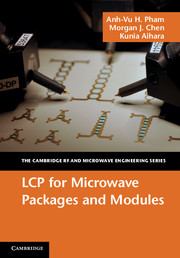Book contents
- Frontmatter
- Contents
- Preface
- 1 Introduction to electronic package engineering
- 2 Characteristics of liquid crystal polymer (LCP)
- 3 Fabrication techniques for processing LCP
- 4 LCP for wafer-level chip-scale MEMS
- 5 LCP for surface mount interconnects, packages, and modules
- 6 LCP for passive components
- 7 LCP for system design
- 8 LCP reliability
- Abbreviations, acronyms, and symbols
- Index
- References
5 - LCP for surface mount interconnects, packages, and modules
Published online by Cambridge University Press: 05 July 2012
- Frontmatter
- Contents
- Preface
- 1 Introduction to electronic package engineering
- 2 Characteristics of liquid crystal polymer (LCP)
- 3 Fabrication techniques for processing LCP
- 4 LCP for wafer-level chip-scale MEMS
- 5 LCP for surface mount interconnects, packages, and modules
- 6 LCP for passive components
- 7 LCP for system design
- 8 LCP reliability
- Abbreviations, acronyms, and symbols
- Index
- References
Summary
This chapter presents the design and development of thin-film LCP surface mount (SMT) package feed-throughs for DC to Ka-band applications. Three types of feed-through design will be introduced, via feed, bandpass feed, and lumped element feed, that interface signals from the outside world to a component inside a package. The packages are constructed using multilayer LCP films and are surface mounted on a printed circuit board (PCB) for use. The utilization of an all-LCP enclosure provides a hermetic environment for microwave and millimetre-wave monolithic integrated circuits (MMICs). In addition, mounting MMICs inside a package cavity allows enhanced thermal dissipation because the metal submounts can make direct contact with the PCB or motherboard ground through solder or epoxy. Applications that require lightweight, hermetic, and low-loss modules, which can be developed using LCP, include, but are not limited to, vehicular-collision-warning short-range radar, radar for ground-moving vehicles, point-to-point communication, ground–satellite communication, intersatellite links, and airborne radar. A phased-array system for ground-vehicle or airborne applications may require thousands of modules in the RF link. If each module, typically cased in ceramic and metal, were replaced with LCP packages, then the total weight of a system could be reduced by more than 66%, because ceramic [1] is three times denser than LCP [2]; this can lead to improvements in fuel efficiency.
Section 5.1 shows the design, the modeling, and measurement process of a Ka-band package feed-through using vias. The experimental results demonstrate that a package via feed-through including a PCB signal launch structure and bond wires achieves a return loss of better than 20 dB and an insertion loss of less than 0.4 dB at the Ka-band. The package has a measured port-to-port isolation greater than 45 dB up to 40 GHz. An amplifier packaged inside an LCP SMT package is characterized. The measured data are then compared with a circuit-model simulation of the package feed-through, using the on-wafer data of an amplifier to validate the lumped-circuit model.
- Type
- Chapter
- Information
- LCP for Microwave Packages and Modules , pp. 97 - 159Publisher: Cambridge University PressPrint publication year: 2012



